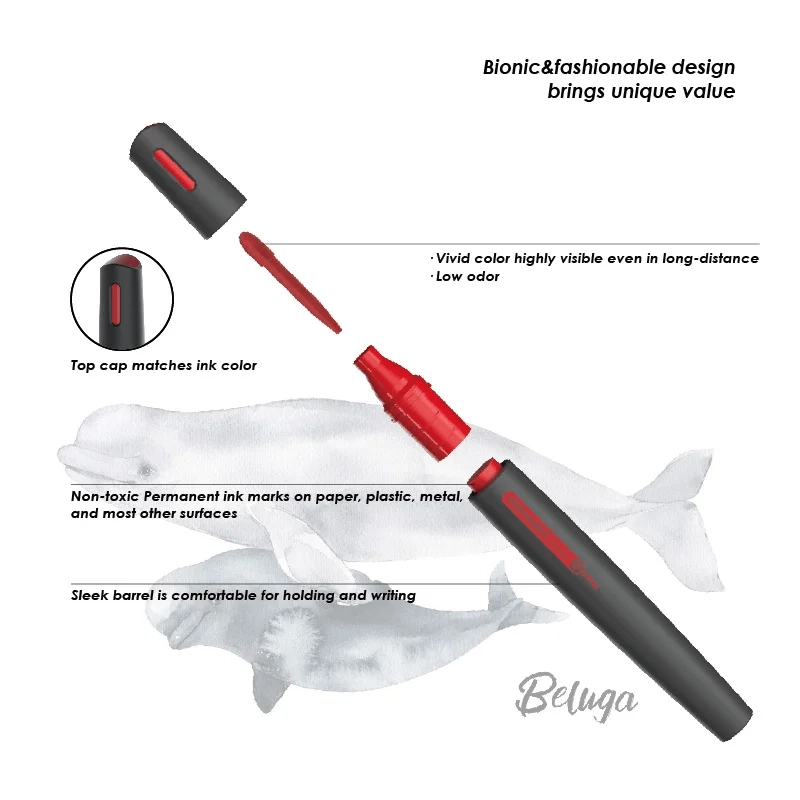Different types and color options of permanent markers
3 min readMarking tools play an integral role in daily life and work. Among them, permanent markers are one of the most preferred marking options due to their excellent durability and non-fading properties. Whether you're working indoors, outdoors, or creating art, permanent markers provide long-lasting, distinctive lines. This article will take an in-depth look at the different types of permanent markers and color options to help users better understand and use this useful tool.
First, let’s start with the basic types of permanent markers. Permanent markers can be roughly divided into three categories based on their purpose and ink composition: water-based permanent markers, oil-based permanent markers, and alcohol-based permanent markers.
Water-based permanent markers, the most common type, use water as the solvent and are generally suitable for use on paper, plastic, and other impermeable surfaces. The advantages of this marker are that it writes smoothly, dries quickly, and is not easily blurred by moisture or humid environments.
Oil-based permanent markers use oil as the base of their ink, which allows them to leave lasting marks on a wider variety of surfaces, including metal, glass, and various plastics. Additionally, oil-based inks are more resistant to UV rays and heat, making them suitable for use in outdoor environments.
Alcohol-based permanent markers are somewhere between water-based and oil-based, using alcohol as a solvent. They are typically used on surfaces that need to dry quickly and be able to withstand a certain amount of wear and tear.

Next, let's talk about permanent marker color choices. Basic colors include black, blue, red, etc., which are suitable for most daily marking needs. Black is the most commonly used color because it provides clear visuals on almost all surfaces. Blue is a friendlier choice, often used for correction and guidance, while red is often used for highlighting important marks or emergencies.
In addition to the basic colors, there are also many bright and special color options available in the market, such as green, yellow, pink, purple, and even white. These colors can be used to distinguish between different areas or coding systems or to add a personalized touch to arts and crafts projects.
Special-purpose permanent markers also include high-temperature series, fluorescent series, and two-color series. The high-temperature resistant series can maintain marking stability in environments withstanding high temperatures and is ideal for use in plastic products or heat treatment processes. The fluorescent series can glow in the dark and are suitable for safety warnings or night identification. Bicolor collections combine two colors, often used to highlight or create a contrasting effect.
When choosing the right permanent marker, users need to consider several key factors. The first is the intended surface of use, as different materials may respond differently to ink absorption and adhesion. Second is environmental conditions such as humidity, temperature, and light conditions, which may affect the durability of the mark. Finally, there are personal or professional needs, different tasks may require different colors and types of markers to complete.
There are also a few things to note when using permanent markers to ensure the best results. For example, it should be tested on waste paper before use to determine ink flow and drying time. Make sure the surface is clean and free of oil and dirt before marking to avoid affecting the adhesion of the ink. If markings need to be erased or corrected, wipe them gently with alcohol or a specialized cleaner.
In conclusion, the permanent marker is a versatile and useful tool that can meet a variety of marking needs. By understanding the different types of permanent markers and color options, users can more precisely select the most appropriate product for a specific task. Whether in the office, factory, or creative studio, the right permanent marker can help you leave a clear, lasting mark.
mia
marketing@johnshen.com
